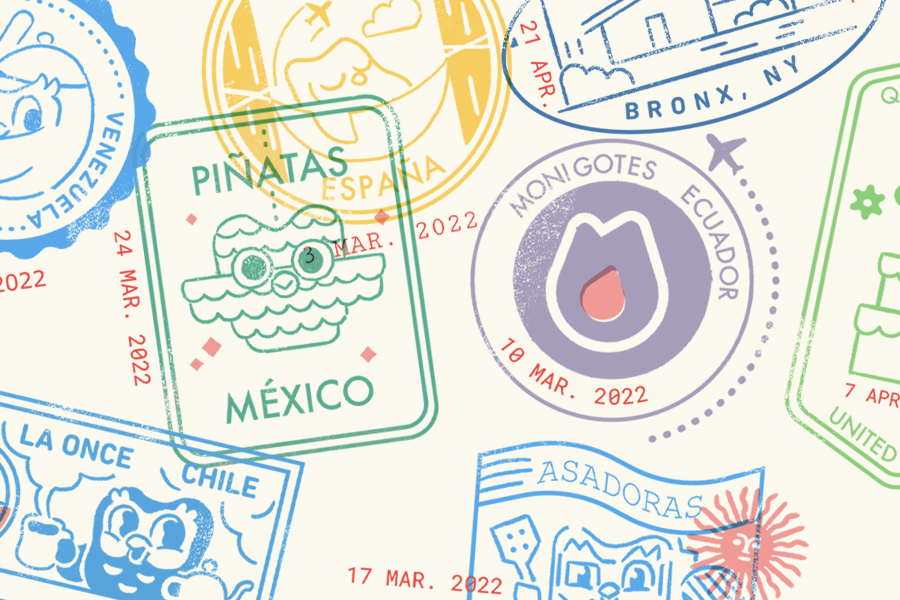In the United States, September 15 through October 15 is recognized as Hispanic Heritage Month! Here at Duolingo, along with our LatinxERG (employee resource group), we recognize and celebrate what makes us unique!
Duolingo is an international company (did you know our two founders were international students?) and this month we’d like to recognize a few of our LatinxERG members as they talk about something we can all feel passionate about: food!
 Kim, Regional Marketing Manager
Kim, Regional Marketing Manager
Favorite food: Sopa de fideos
I was born and raised in Mexico City and I’m currently the Regional Marketing Manager for Hispanic Latin America at Duolingo. If I try to think of what my childhood tasted like, the first thing that comes to mind is sopa de fideos (noodle soup). I'd come home from school, and as soon as I saw my abuela's cazuela (grandma's pot) on the stove simmering and smelled the toasty delicious aroma of the sopita my day instantly got a hundred times better.
Sopa de fideos is Mexico's answer to chicken noodle soup. It's the kind of dish that makes you feel instantly at home, no matter where you are, almost like a culinary comfort blanket that wraps you up in its warmth and flavor. It's nothing fancy compared to dishes like mole or chiles en nogada: It’s thin pasta toasted and fried to perfection, a tasty tomato broth, and a few crackers floating around—my grandma called them barquitos (little boats). Sopa de fideos goes beyond just being food, it's a piece of Mexico's heart and soul. Now as a grown woman, I still get the exact same feeling I did back then when returning home from school when a bowl of sopita is in front of me. I'll close my eyes, take in the delicious aroma, and instantly feel at home again surrounded by the people I love most no matter where in the world I may be. If you’ve never tried it, I suggest doing so on a rainy day or when you really need a pick-me-up. And don’t forget the barquitos!
 Nico, Principal Product Manager
Nico, Principal Product Manager
Favorite food: Empanadas
I was born in Patagonia in Argentina, and I’m currently a Principal Product Manager at Duolingo, working on social features that bring learners closer to one another. When I think about food from Argentina, there are several typical dishes that I miss a lot, but one food that brings me back to large gatherings: empanadas.
Empanadas are more than just a delicious Argentine staple—they are the epitome of togetherness, comfort, and the embodiment of Argentine culture. These delightful pockets of dough filled with an assortment of tasty ingredients are the go-to choice for large gatherings with friends and family. Whether it's a casual meetup or a special occasion, empanadas are the culinary thread that weaves together the rich tapestry of shared experiences, laughter, and camaraderie.
The beauty of empanadas lies in their versatility, reflecting the diverse tastes and preferences of the people who enjoy them. While some prefer their empanadas baked to golden perfection, others love the irresistible crunch of the fried version. The variety of fillings cater to every palate, from the classic minced meat or chicken, to the mouthwatering combination of ham and cheese, and even the bold flavors of blue cheese or spicy meat. There are also regional twists and variations, such as the savory cheese and onion empanada, which is a true testament to the adaptability of this Argentine treasure. No matter how they're prepared, one thing is certain: Empanadas have a special place in the hearts of those who have had the pleasure of savoring them.
 Alexa, Senior Creative Producer
Alexa, Senior Creative Producer
Favorite food: Tostones
¿Qué lo que? I’m Alexa, and I was born and raised in New York and my family is from the Dominican Republic. Growing up in a Dominican household, tostones have always been a staple dish. These fried plantain snacks are served as a side with every meal. The best tostones are served hot off the pan, crispy and warm, needing nothing more than a sprinkle of salt. Since I was a kid, barely tall enough to reach the counter, I'd help my mom make them. Those moments in our kitchen were always full of laughter, sneaking bites of food before serving the family. But I also learned so much about the unspoken rules and knowledge of Dominican cooking that many of the matriarchs in my family have safeguarded for generations.
The best part of making tostones, aside from eating them, of course, is mashing them! The process of mashing to perfection is cathartic and downright fun. We use a special appliance called a tostonera, a wooden 'masher' that can be found in most Dominican households. There's an art to mashing the plantains: You can't mash too hard or they'll be too thin and fall apart in the oil, but they also can't be too thick or they'll lose their crispiness. It has to be just the right amount (a skill that took years to perfect!). To this day, we still share the joy of making these salty snacks for our family. And of course, I always grab the crispiest, crunchiest tostone before it reaches the table–I deserve it! I will always cherish the memories of making food with my mom, and I hope to keep this tasty tradition alive with my future family.
 Xavier, Talent Acquisition Manager
Xavier, Talent Acquisition Manager
Favorite food: Arepas
I was born in Maracaibo, Venezuela, where food plays a significant role in our culture. There are many Venezuelan dishes that I could talk about, but nothing beats an arepa. It's a staple in our diet, and we start eating it at a young age. My first arepa, like many Venezuelans, was with butter and Venezuelan cheese. The best thing about arepas is that they can be filled with almost anything and can be eaten for breakfast, lunch, dinner or as a late-night snack. Making them is a simple process, but there is a debate about the order of adding the ingredients. Some prefer to add harina (a type of flour) first, while others suggest adding water first. Personally, I recommend following my mom's advice of adding water to the harina. In my opinion, she makes the best arepas.
My favorite is the Arepa de Pabellon. It is a combination of two of my favorite dishes from back home: arepas and Pabellon Criollo, which is the national dish of Venezuela. It’s filled with carne mechada (Venezuelan shredded beef), plantains, black beans, and Venezuelan cheese. Although I can enjoy this dish at Cilantro and Ajo in Pittsburgh, I always dream of the day I can have it again in Venezuela with my family.
Here's a recipe (er, video) I love!
Thanks to these Duos for sharing their favorite foods and memories to celebrate Hispanic Heritage Month. Is anyone else suddenly hungry, or just us!?



